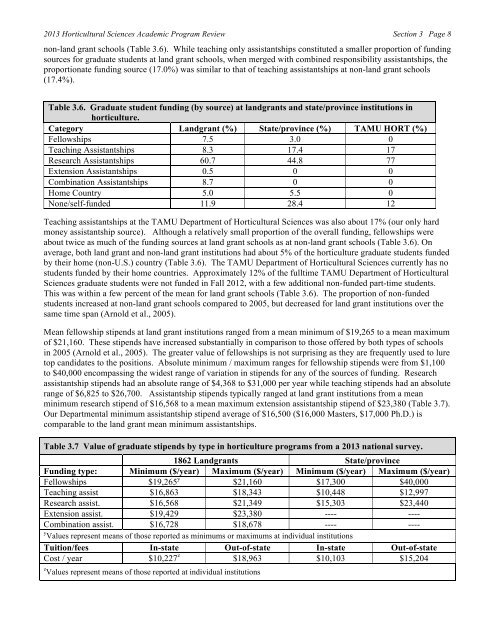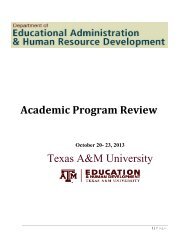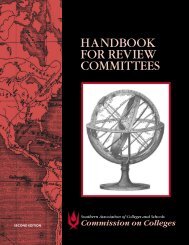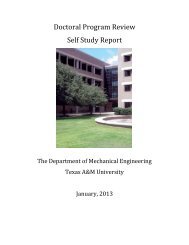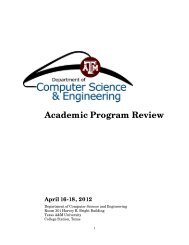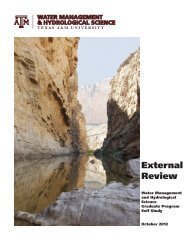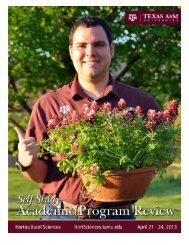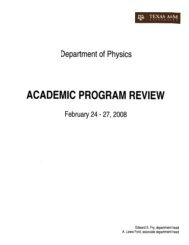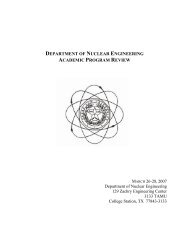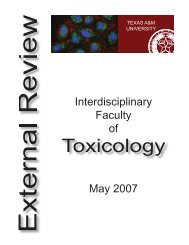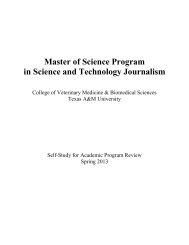its - Office of the Provost and Executive Vice President for Academic ...
its - Office of the Provost and Executive Vice President for Academic ...
its - Office of the Provost and Executive Vice President for Academic ...
You also want an ePaper? Increase the reach of your titles
YUMPU automatically turns print PDFs into web optimized ePapers that Google loves.
2013 Horticultural Sciences <strong>Academic</strong> Program Review Section 3 Page 8<br />
non-l<strong>and</strong> grant schools (Table 3.6). While teaching only assistantships constituted a smaller proportion <strong>of</strong> funding<br />
sources <strong>for</strong> graduate students at l<strong>and</strong> grant schools, when merged with combined responsibility assistantships, <strong>the</strong><br />
proportionate funding source (17.0%) was similar to that <strong>of</strong> teaching assistantships at non-l<strong>and</strong> grant schools<br />
(17.4%).<br />
Table 3.6. Graduate student funding (by source) at l<strong>and</strong>grants <strong>and</strong> state/province institutions in<br />
horticulture.<br />
Category L<strong>and</strong>grant (%) State/province (%) TAMU HORT (%)<br />
Fellowships 7.5 3.0 0<br />
Teaching Assistantships 8.3 17.4 17<br />
Research Assistantships 60.7 44.8 77<br />
Extension Assistantships 0.5 0 0<br />
Combination Assistantships 8.7 0 0<br />
Home Country 5.0 5.5 0<br />
None/self-funded 11.9 28.4 12<br />
Teaching assistantships at <strong>the</strong> TAMU Department <strong>of</strong> Horticultural Sciences was also about 17% (our only hard<br />
money assistantship source). Although a relatively small proportion <strong>of</strong> <strong>the</strong> overall funding, fellowships were<br />
about twice as much <strong>of</strong> <strong>the</strong> funding sources at l<strong>and</strong> grant schools as at non-l<strong>and</strong> grant schools (Table 3.6). On<br />
average, both l<strong>and</strong> grant <strong>and</strong> non-l<strong>and</strong> grant institutions had about 5% <strong>of</strong> <strong>the</strong> horticulture graduate students funded<br />
by <strong>the</strong>ir home (non-U.S.) country (Table 3.6). The TAMU Department <strong>of</strong> Horticultural Sciences currently has no<br />
students funded by <strong>the</strong>ir home countries. Approximately 12% <strong>of</strong> <strong>the</strong> fulltime TAMU Department <strong>of</strong> Horticultural<br />
Sciences graduate students were not funded in Fall 2012, with a few additional non-funded part-time students.<br />
This was within a few percent <strong>of</strong> <strong>the</strong> mean <strong>for</strong> l<strong>and</strong> grant schools (Table 3.6). The proportion <strong>of</strong> non-funded<br />
students increased at non-l<strong>and</strong> grant schools compared to 2005, but decreased <strong>for</strong> l<strong>and</strong> grant institutions over <strong>the</strong><br />
same time span (Arnold et al., 2005).<br />
Mean fellowship stipends at l<strong>and</strong> grant institutions ranged from a mean minimum <strong>of</strong> $19,265 to a mean maximum<br />
<strong>of</strong> $21,160. These stipends have increased substantially in comparison to those <strong>of</strong>fered by both types <strong>of</strong> schools<br />
in 2005 (Arnold et al., 2005). The greater value <strong>of</strong> fellowships is not surprising as <strong>the</strong>y are frequently used to lure<br />
top c<strong>and</strong>idates to <strong>the</strong> positions. Absolute minimum / maximum ranges <strong>for</strong> fellowship stipends were from $1,100<br />
to $40,000 encompassing <strong>the</strong> widest range <strong>of</strong> variation in stipends <strong>for</strong> any <strong>of</strong> <strong>the</strong> sources <strong>of</strong> funding. Research<br />
assistantship stipends had an absolute range <strong>of</strong> $4,368 to $31,000 per year while teaching stipends had an absolute<br />
range <strong>of</strong> $6,825 to $26,700. Assistantship stipends typically ranged at l<strong>and</strong> grant institutions from a mean<br />
minimum research stipend <strong>of</strong> $16,568 to a mean maximum extension assistantship stipend <strong>of</strong> $23,380 (Table 3.7).<br />
Our Departmental minimum assistantship stipend average <strong>of</strong> $16,500 ($16,000 Masters, $17,000 Ph.D.) is<br />
comparable to <strong>the</strong> l<strong>and</strong> grant mean minimum assistantships.<br />
Table 3.7 Value <strong>of</strong> graduate stipends by type in horticulture programs from a 2013 national survey.<br />
1862 L<strong>and</strong>grants State/province<br />
Funding type: Minimum ($/year) Maximum ($/year) Minimum ($/year) Maximum ($/year)<br />
Fellowships $19,265 y $21,160 $17,300 $40,000<br />
Teaching assist $16,863 $18,343 $10,448 $12,997<br />
Research assist. $16,568 $21,349 $15,303 $23,440<br />
Extension assist. $19,429 $23,380 ---- ----<br />
Combination assist. $16,728 $18,678 ---- ----<br />
y Values represent means <strong>of</strong> those reported as minimums or maximums at individual institutions<br />
Tuition/fees In-state Out-<strong>of</strong>-state In-state Out-<strong>of</strong>-state<br />
Cost / year $10,227 z $18,963 $10,103 $15,204<br />
z Values represent means <strong>of</strong> those reported at individual institutions


